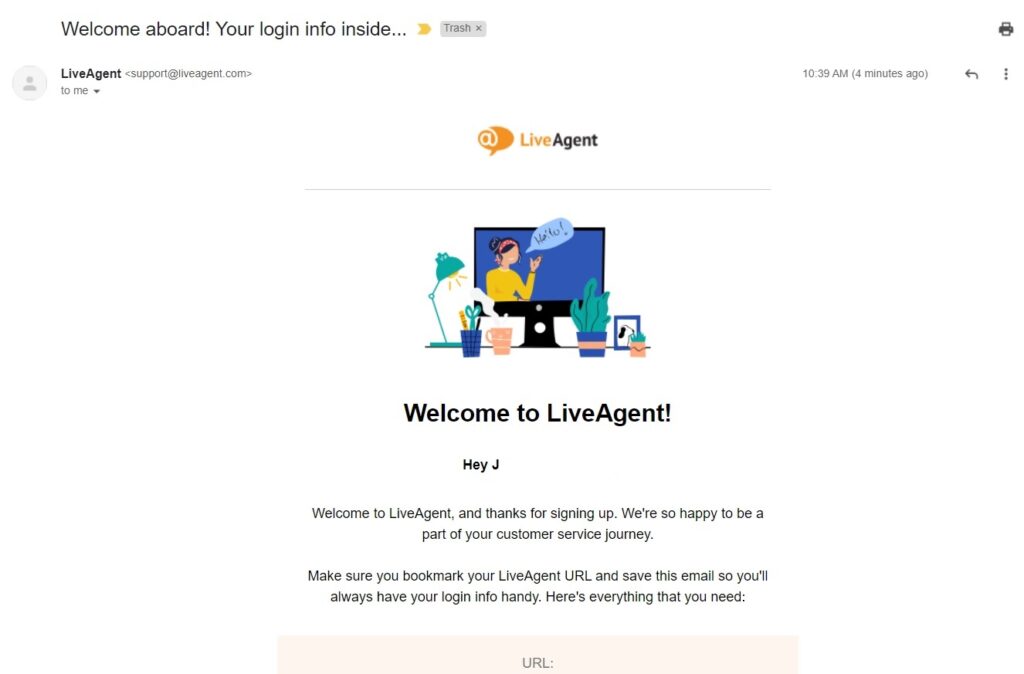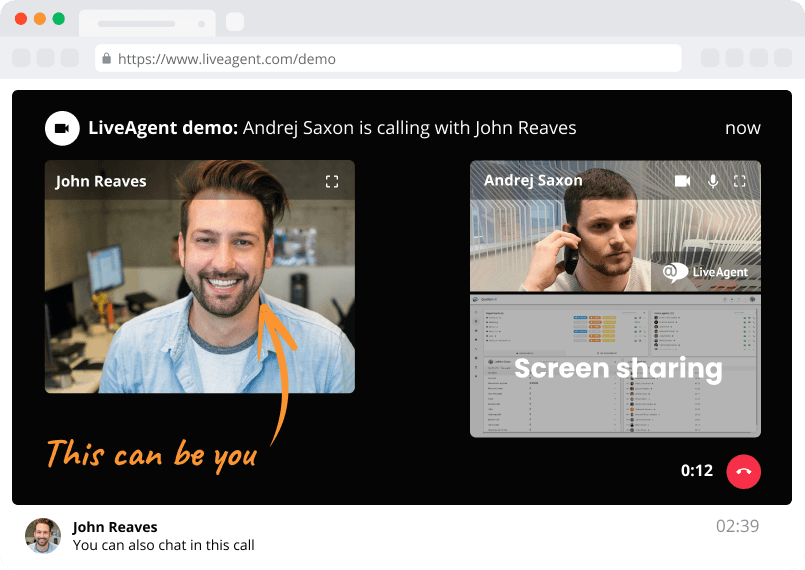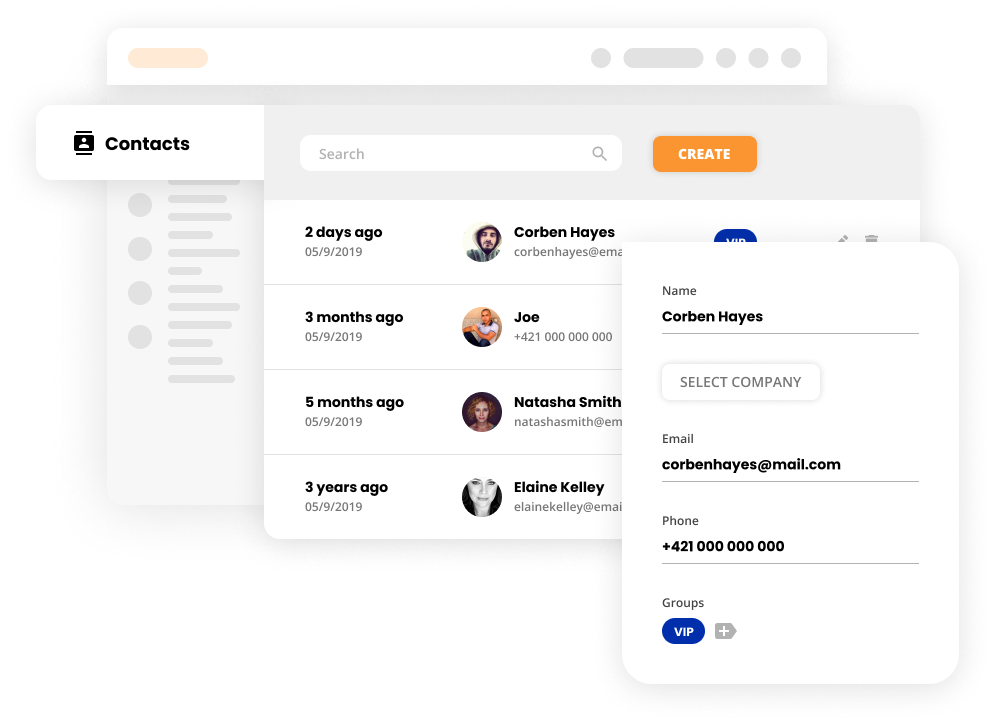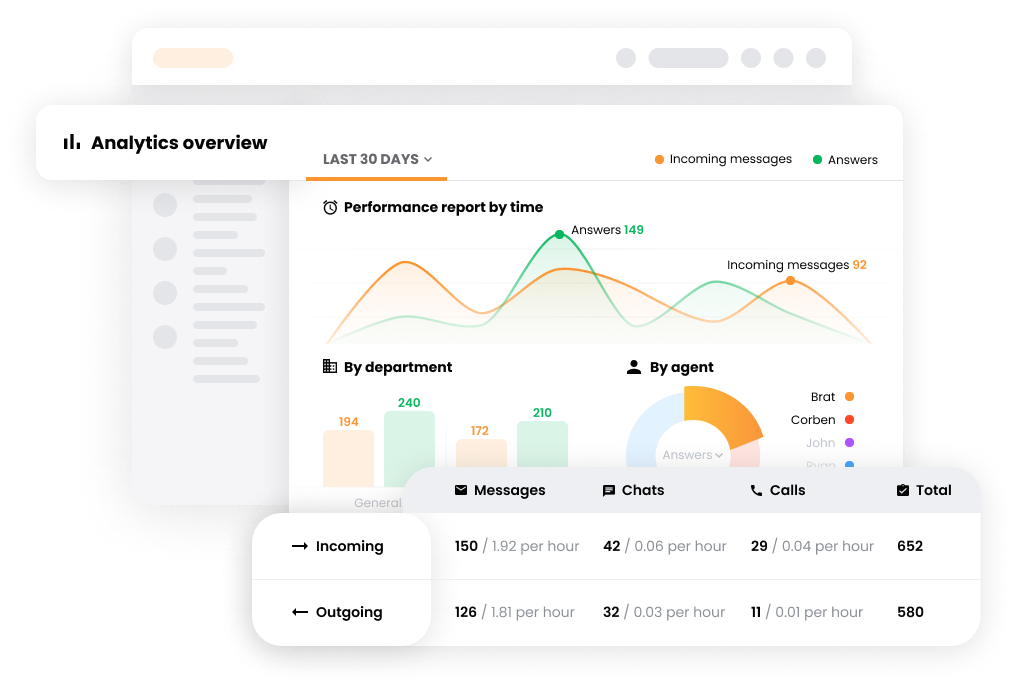- All checklists
- Customer Service
- New client onboarding checklist
New client onboarding checklist
The new client onboarding checklist by LiveAgent helps businesses streamline onboarding by assigning sales and customer care reps, validating contracts, scheduling meetings, and setting goals. It ensures efficient onboarding, improving client satisfaction and retention.

- Assign a sales representative
- Assign a customer care representative
- Validate the contract
- Send a welcome email
- Schedule a meeting with the client
- List all of the client’s questions and concerns
- Catalog any red flags or issues the client has
- Identify the client’s expectations
- Set short and long term goals
- Keep track of the client’s data with LiveAgent
- Assess customer usage of services/tools
- Note any increase or decrease in usage
-
Customer Service
-
Customer Service Standards
-
Customer Service Quality Assurance
-
Customer Complaint Handling
-
Customer Service Evaluation
-
Help Desk Quality Assurance
-
VoIP Implementation
-
Customer Service Audit
-
IT Help Desk Audit
-
Help Desk
-
Customer Service Call Quality
-
Customer service skills checklist
-
Customer Service Agents Training
-
Know Your Customer
-
SaaS Customer Onboarding
Are you a business owner who is looking for ways to improve your client onboarding process? If so, you’re in the right place – this post will provide you with a new client onboarding checklist template to help make the process smoother and less stressful for both you and your clients. Keep reading for more information.
The importance of a new client onboarding checklist
As a business owner, it’s important to have a new client onboarding checklist in place to ensure that people have the best possible customer experience with your company. By having a checklist to follow, you can speed up the customer onboarding process and make it more efficient.
Who can benefit from a new client onboarding checklist?
- Business owners
A new client onboarding checklist can help you to streamline your process and make sure that you’re providing the best possible service to your customers. By following a checklist, you can be sure that all of the necessary steps are being taken care of so that your clients are happy with their experience.
- Managers
Managers are often responsible for the client onboarding experience, that’s why they should be provided such a checklist. It helps them avoid overlooking something important, make sure that all the necessary steps are taken, and improve efficiency by avoiding duplication.
- Customer service representatives
A new client onboarding checklist allows customer service agents to quickly and easily get a new customer set up with your company and its products or services. It can also help to avoid mistakes and deliver a positive client experience from the start.
- Customers
Customers also benefit from a new client onboarding checklist. By having all the necessary information and documents in one place, they will know what to expect and thus avoid frustration. A good customer onboarding experience can lead to them doing repeat business with your company and leaving positive online reviews.
Explore our new client onboarding checklist
This person will be responsible for maintaining contact with the client, as well as providing them with information about your company and its products or services.
Why is it important to assign a sales representative?
A sales representative is the key contact between a customer and the company they are doing business with. The designated person will be responsible for building relationships and ensuring that the customer has a positive experience. The client’s sales representative should therefore be someone who can be relied on for answers to any key questions or concerns.
How to assign a sales representative?
The manager in charge of the client onboarding process should assign a sales representative. The manager will take into account the customer’s needs and requirements, as well as the company’s products or services, to decide who would be the best person to assign to each particular client.
What tools to use for assigning a sales representative?
- customer relationship management (CRM) system – to keep track of interactions and account status
- company directory – to find contact information for employees
- email client – to communicate with the sales representative assigned to the customer
The assignee in this case will be responsible for supporting the customer and answering any questions they may have.
Why is it important to assign a customer care representative?
Whenever the client has a question or encounters a problem, they will need to be able to rely on someone who can provide them with answers and resolve the issue on time.
How to assign a customer care representative?
A customer care representative can be assigned in the same way as a sales representative, by the manager in charge of the client onboarding process. They will therefore follow a similar process as the previous step to assign someone who they believe would be the best fit for a particular client.
What tools to use for assigning a customer care representative?
- customer relationship management (CRM) system – to keep track of interactions and account status
- company directory – to find contact information for employees
- email client – to communicate with the customer care representative assigned to the customer
The contract is a key document that will outline the terms of the agreement between your company and the client.
Why is it important to validate the contract?
A contract is a legally binding document that outlines the terms of an agreement between two or more parties. It is important to validate the contract to make sure that the terms are fair and reasonable, all of the details are correct, and both parties are happy with the sales process agreement before proceeding.
How to validate the contract?
The manager in charge of the client onboarding process will review the contract and make sure that all the terms are clear and concise. They will also check that all of the details are accurate and that both parties are happy with the agreement.
What tools to use for validating a contract?
- company directory – to find contact information for the client
- email client – to communicate with the client about the contract
- contract template – to create a draft of the agreement
Greeting your new client is a great way to start the onboarding process.
Why is it important to send a welcome email?
A welcome email is a courteous gesture that helps to create a good first impression. It also provides an opportunity to introduce the company and its products or services, as well as to explain what the client can expect from the onboarding process.
How to write a welcome email?
It is one of the duties of the previously assigned sales representative, who will introduce themselves in the process, to send a welcome email to the client. This message should also include an overview of what the client can expect during their onboarding, contact details (e.g. email address) for their customer care representative, an attached copy of the contract, and any other relevant information.

What tools to use for sending a welcome email?
- email client – to compose and send the welcome email
- company directory – to find client details including contact information
- contract template – to attach a copy of the agreement to the email
To proceed with the customer onboarding process, you should arrange to meet with them either in person or online.
Why is it important to schedule a meeting with the client?
This is the best opportunity to go over all of the details of the contract, answer any questions they have, and ensure that they understand the agreement. This meeting also gives you the chance to explain what the client can expect from the remainder of the onboarding process.
How to schedule a meeting with the client?
The sales representative responsible for the client will arrange a time and date that works for both parties, and they will also choose the best format for the meeting (in-person or online). Note that this could be initiated as part of the welcome email in the previous step.

What tools to use for scheduling a meeting with the client?
- meeting scheduler – to find a time that works for both parties
- video conferencing software – to hold an online meeting (if applicable)
During the meeting, the client will likely have key questions and some concerns about the onboarding process, the contract, and/or your future relationship.
Why is it important to list all of the client’s questions and concerns?
Doing so will allow you to address all of them during the meeting. This will help to ensure that the client feels heard and that their concerns are being taken seriously, as well as identify any areas where the client may need more clarification.
How to list all of the client’s questions and concerns?
The assigned sales representative should take notes about any issues the client raises during the meeting. Alternatively, they can ask the client if it would be okay to record the conversation so that they can go back and review the details later.
What tools to use for listing all of the client’s questions and concerns?
- notepad (physical or software) – to write down all of the questions and concerns
- voice recorder – to record the meeting (if applicable)
- video conferencing software – to record the online meeting (if applicable)
As you are going over the questions and concerns raised by the client, you may identify some potential roadblocks.
Why is it important to catalog any red flags or issues the client has?
This is an opportunity to address them directly and make the client feel comfortable moving forward with the onboarding process. It will also allow them to indicate any areas where the company may need to make some changes.
How to catalog any red flags or issues the client has?
Take note of any red flags or issues that are brought up by the client. The sales representative who is responsible for the client can either write them down or record them.
What tools to use for cataloging any red flags or issues the client has?
- word processor – to note the red flags or issues
- spreadsheet – to catalog the red flags or issues and their status
After all questions and concerns have been addressed, it is time to find out precisely what the client hopes to get out of doing business with your company.
Why is it important to define the client’s expectations?
It means that both parties will be on the same page moving forward and that there are no surprises down the road. It is also an opportunity to set realistic objectives for what the company can and can’t provide.
How to identify the client’s expectations?
During the meeting, you should ask the client directly about their expectations. You can also inquire about their goals and objectives to get a better sense of what they are looking for.
What tools to use for identifying the client’s expectations?
- notepad (physical or software)
- word processor
- video conferencing software
Now that you know what the client wants, it is time to start setting some aims.
Why is it important to set short and long-term goals?
It gives you a roadmap for your future relationship with the client going forward. It also allows you to track progress and have a measure of success over time.
How to set short and long-term goals?
The goals should be specific, measurable, achievable, relevant, and time-bound. They should also be aligned with client expectations.
What tools to use for setting short and long-term goals?
- SMART goal setting worksheet – to list the goals
- project management tool – to track the progress of the goals over time
- CRM software – to keep track of the client relationship
Now that you have a new client, it is important to store their information and keep it updated.
Why is it important to keep track of the client’s data?
This information will be used to communicate with the client, understand their needs, and provide them with the best possible service. It will also help you keep track of your interactions with the client and measure their satisfaction over time.
How to keep track of the client’s data?
You can use LiveAgent’s help desk contacts to store the client’s name, email, phone number, and other personal information. Help desk software like LiveAgent also enables you to create custom contact fields to store unique information about your customers for more personalized communication.

What tools to use for keeping track of the client’s data?
- LiveAgent – to store customer information with its help desk contacts feature
Once the new client has started with your business, it is time to determine how they are using your services or tools.
Why is it important to assess customer usage of services/tools?
It will help you understand how the client is using your products or services and whether or not they are getting the most out of them. It can also help you identify any areas where the client may need more support.
How to assess customer usage of services/tools?
By asking the client directly, observing their behavior, reviewing data and analytics, and/or conducting user tests. Then, you can compare this information to your goals and objectives to see how well the client’s usage compares.

What tools to use for assessing customer usage of services/tools?
- user testing software – to observe how the client uses your product or service
- analytics software – to review the client’s usage data
- client onboarding questionnaire – to ask them directly about their experience
After you have assessed the client’s usage of your services, note any changes in their behavior.
Why is it important to note any increase or decrease in usage?
This allows you to understand how well the client is using your products or services. According to this information, you can suggest additional services or support.
How to note any increase or decrease in usage?
By tracking the data and analytics over time, you can see how the client’s usage changes. If you notice a decrease in usage, you can reach out to the client to see if they need any help.
What tools to use for noting any increase or decrease in usage?
- analytics software
- customer success software – to reach out to the client and offer support
- client questionnaire
Tips for following up with new clients
- Send a personalized thank-you note within 24 hours of meeting the client
It is always a good idea to send a thank-you note after meeting with a new prospective client. This follow-up email, or another type of message, shows that you are interested in building the relationship and that you are grateful for their business.
- Add the new client to your mailing list and send them occasional updates on your business
You will be able to keep them up to date on your business and build a strong relationship with them over time. As a result, they will be more likely to use your products or services in the future.
- Connect with the client on social media and follow their updates
Social media is a great way to stay in touch with your clients – by following their updates, you can learn more about them and their interests. As a result, you will be able to provide them with better service and reduce client churn.
- Invite the client to events or networking meetings relevant to their industry
By doing so, you will be able to show them that you are interested in their business and that you want to help them grow. This will also allow you to learn more about their industry and build your network.
- Offer free resources or consultation services that may be beneficial to the client
This will show the client that you are interested in their success, and it also allows you to provide them with valuable information or services. A small gesture like this can go a long way in building a strong relationship with the client.
- Check in with the client periodically to see how they’re doing
By contacting them regularly, even with just a quick call or an email, you can be sure that they are happy with your products or services. This way you can also offer them additional support if needed.
Summary of the new client onboarding checklist
- Assign a sales representative
- Assign a customer care representative
- Validate the contract
- Send a welcome email
- Schedule a meeting with the client
- List all of the client’s questions and concerns
- Catalog any red flags or issues the client has
- Identify the client’s expectations
- Set short and long term goals
- Keep track of the client’s data with LiveAgent
- Assess customer usage of services/tools
- Note any increase or decrease in usage
Frequently Asked Questions
How often should I update my new client onboarding checklist?
It depends on your business and how often your processes change, but ideally, you should update it whenever there are changes in your company’s procedures, products, or customer base. It can also be helpful to review your checklist periodically to see if there are any areas where you could improve efficiency.
Can I automate parts of my new client onboarding process using tools?
Yes, with software such as CRMs, email marketing platforms, and project management tools. Using technology to automate your new client onboarding process can save you time and energy, as well as help you to keep track of your new clients more easily.
How can I make the new client onboarding process easier for them and myself?
Plan out the steps you will take in advance, i.e. by following a checklist such as the one given here, and make sure that everything your new client needs is ready and waiting for them when they come on board. The easier you make it for your new clients to get started, the more likely they are to be satisfied with your services and stay with you for a long time. This, in turn, will increase your average customer lifetime and client retention rates.
What are some common mistakes businesses make during the new client onboarding process?
There are many factors to consider when onboarding a new client, but here are some of the most common errors include not communicating the expectations and goals of the project to the client, inadequately explaining or demonstrating how your product or service works, failing to create a timeline or set deadlines for completion, and not following up with clients after work is completed.
Can I outsource my new client onboarding process to a third-party provider?
When deciding about this, ask yourself ‘Will they be able to provide a level of service that meets or exceeds my expectations?’, ‘Are they capable of keeping up with my company’s growth?’, ‘Can they be trusted to handle sensitive customer data?’, and ‘Is their solution going to be cost-effective?’ If you answer ‘yes’ to all of these questions, then outsourcing your new client onboarding process may be the best option for your business. But if you answer ‘no’ to any, it may be best to keep the onboarding process in-house.
Discover how LiveAgent's extensive integrations, plugins, and apps can enhance your help desk software and boost customer satisfaction. Explore popular integrations with VoIP partners like Hero, Orion, and Redspot, plus CRM, eCommerce, and more. Visit us to streamline your communication and elevate your business with easy integration guides.
You will be
in Good Hands!
Join our community of happy clients and provide excellent customer support with LiveAgent.

Our website uses cookies. By continuing we assume your permission to deploy cookies as detailed in our privacy and cookies policy.

- How to achieve your business goals with LiveAgent
- Tour of the LiveAgent so you can get an idea of how it works
- Answers to any questions you may have about LiveAgent

 Български
Български  Čeština
Čeština  Dansk
Dansk  Deutsch
Deutsch  Eesti
Eesti  Español
Español  Français
Français  Ελληνικα
Ελληνικα  Hrvatski
Hrvatski  Italiano
Italiano  Latviešu
Latviešu  Lietuviškai
Lietuviškai  Magyar
Magyar  Nederlands
Nederlands  Norsk bokmål
Norsk bokmål  Polski
Polski  Română
Română  Русский
Русский  Slovenčina
Slovenčina  Slovenščina
Slovenščina  简体中文
简体中文  Tagalog
Tagalog  Tiếng Việt
Tiếng Việt  العربية
العربية  Português
Português 





